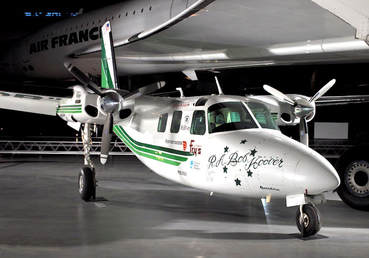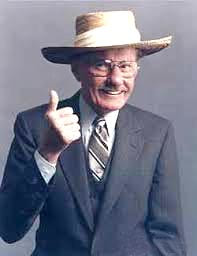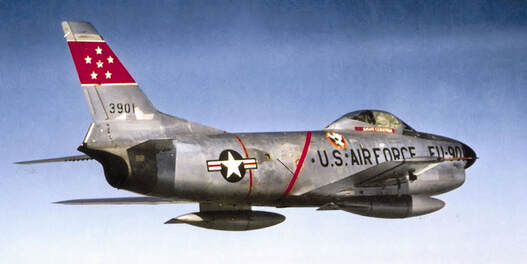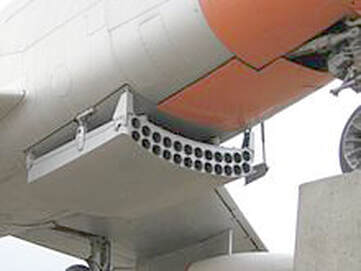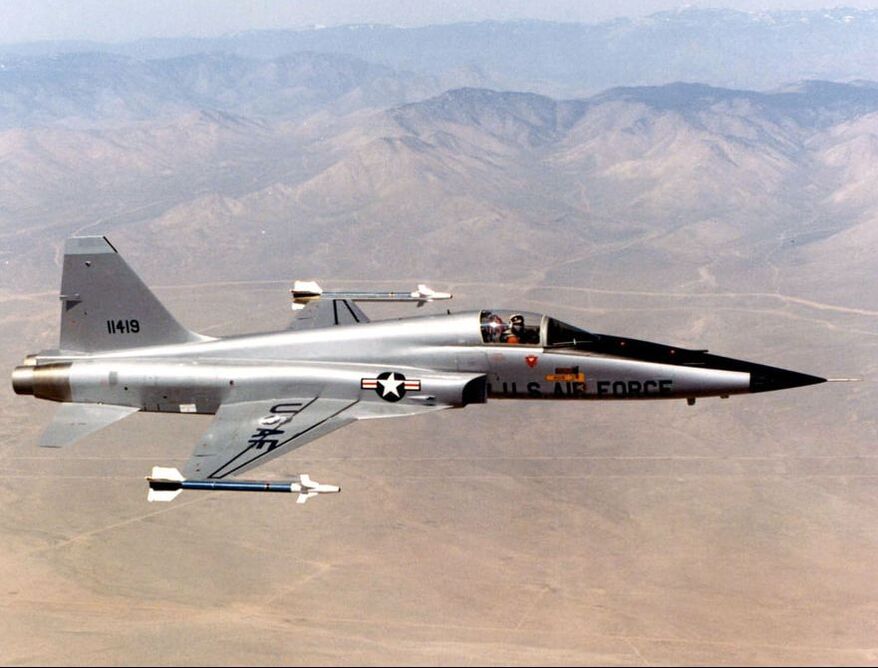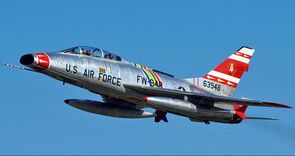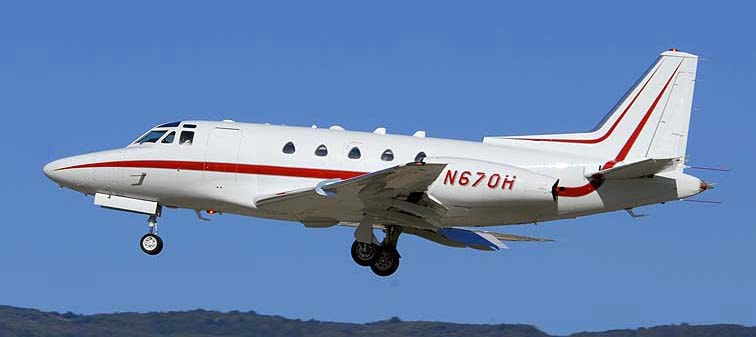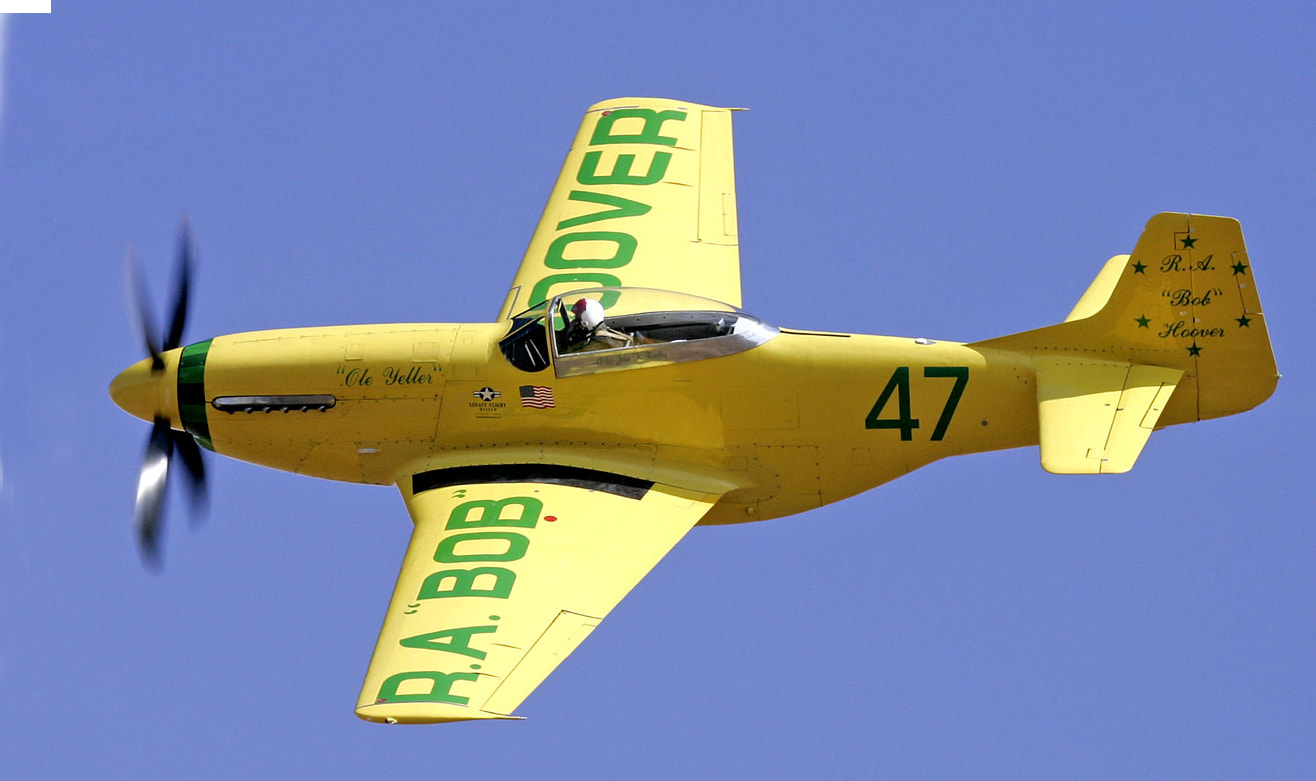R. A. ‘Bob’ Hoover (1922 – 2016) (June 2017)
The most viewed video of Bob Hoover’s flying is this one https://www.youtube.com/watch?v=V9pvG_ZSnCc. .
The aircraft is a Rockwell Shrike Commander, a light twin which can carry six people. The manoeuvre is a barrel roll. That’s like a combination of a loop and a roll and is so called because the aircraft follows a line which could be drawn on the inside of a barrel. Properly done, the ‘g’ which the passengers feel is constant and Bob demonstrates this effectively by placing a glass on the panel and, throughout the roll, pouring iced tea into the glass. He said that the contortions he went through to keep his arm out of the way of the camera were more difficult than flying the roll.
Rockwell had been suffering poor sales of the Shrike and were losing money when they were taken over by North American in 1968. It hadn’t helped when a survey of accidents after the failure of one engine had put the Shrike at the bottom of the list. At the time, Bob Hoover was a North American test pilot. The Vice President for sales had seen Bob’s demonstration of aerobatics in another twin, the P-38 Lightning, which included looping and rolling with one and both engines shut down. Could he could do something similar in a Shrike Commander.
The P-38 had a ‘g’ limit of 7.33. The Shrike’s limit was 4.4. A ‘g’ meter was fitted to the Shrike and Bob developed a barrel rolling and looping display for the National Business Aircraft Maintenance Show. The media were impressed but Rockwell’s competitors were not. The VP told Bob to spice up the display. He suggested a ‘really low’ pass. The belly of the plane was lower than the disc of the propellers so they would be safe but it was difficult for the pilot to know, within inches, exactly where the ground was. An aerial and some paint were scraped off. Bob countered by holding the Shrike on the ground during take-off, raising the undercarriage and performing the really low pass before climbing away. He added weaving approaches and landings on one wheel. Although some pilots found the Shrike difficult to taxi with its unusual braking system Bob’s finale was to shut down both engines, land and roll up to his precise parking position in front of the crowd.
The aircraft is a Rockwell Shrike Commander, a light twin which can carry six people. The manoeuvre is a barrel roll. That’s like a combination of a loop and a roll and is so called because the aircraft follows a line which could be drawn on the inside of a barrel. Properly done, the ‘g’ which the passengers feel is constant and Bob demonstrates this effectively by placing a glass on the panel and, throughout the roll, pouring iced tea into the glass. He said that the contortions he went through to keep his arm out of the way of the camera were more difficult than flying the roll.
Rockwell had been suffering poor sales of the Shrike and were losing money when they were taken over by North American in 1968. It hadn’t helped when a survey of accidents after the failure of one engine had put the Shrike at the bottom of the list. At the time, Bob Hoover was a North American test pilot. The Vice President for sales had seen Bob’s demonstration of aerobatics in another twin, the P-38 Lightning, which included looping and rolling with one and both engines shut down. Could he could do something similar in a Shrike Commander.
The P-38 had a ‘g’ limit of 7.33. The Shrike’s limit was 4.4. A ‘g’ meter was fitted to the Shrike and Bob developed a barrel rolling and looping display for the National Business Aircraft Maintenance Show. The media were impressed but Rockwell’s competitors were not. The VP told Bob to spice up the display. He suggested a ‘really low’ pass. The belly of the plane was lower than the disc of the propellers so they would be safe but it was difficult for the pilot to know, within inches, exactly where the ground was. An aerial and some paint were scraped off. Bob countered by holding the Shrike on the ground during take-off, raising the undercarriage and performing the really low pass before climbing away. He added weaving approaches and landings on one wheel. Although some pilots found the Shrike difficult to taxi with its unusual braking system Bob’s finale was to shut down both engines, land and roll up to his precise parking position in front of the crowd.
Bob Hoover died on 25 October 2016 and a flood of tributes appeared on the internet. ‘A true, one-of-a-kind aviation hero’ - ‘One of history’s greatest pilots’ - ‘The greatest stick and rudder pilot who ever lived’. A decorated WWII fighter pilot, test pilot for the USAF and North American, he achieved world-wide fame as a civilian display pilot, receiving a host of honours and awards. Some of the incidents in his long career are worth re-telling.
Born in Nashville, Tennessee, Bob Hoover was determined to be a pilot. His heroes were Lindbergh and the flamboyant Roscoe Turner whom he met, with his lion, Gilmour. As a teenager, he earned $2 from his part-time job. It was enough to buy just 15 minutes instruction in a Piper Cub at the weekend. The shortness of the flights was a bonus because Bob found he suffered seriously from air-sickness. It took a year before he was ready to fly solo. He forced himself to overcome the nausea by practising stalls, spins, tight turns, even aerobatics.
He joined the Tennessee National Guard where he met Denny McClendon, another keen aviator. They bought a wrecked Piper Cub which they re-built and took on a barn-storming holiday, selling rides for $1. It all ended in September, 1940 when the National Guard was mobilized for full-time duty.
Bob learned he could apply for pilot training. At the medical, all was well except that he couldn’t read the eye chart when his eyes were dilated. The Medical Officer, himself a pilot, saw how disappointed Bob was and left the room for a few minutes. Using his short term memory, Bob passed.
His flying training went well and he passed out from training school with the highest grades, survived a dead-stick landing in a P-39 Airacobra with its engine in flames and ditched a P-40 Kittyhawk in a lake when he was shot down in gunnery practice by another student.
Posted overseas, his flying record singled him out and, although he was only a sergeant, he was put in charge of 67 pilots. By the time he reached Algeria, now a Flight Officer (equivalent to a Warrant Officer) he was not posted to a combat unit like the other pilots but retained to test fly the fighters which arrived in crates. ‘Testing’ to Hoover was the full range of spins and aerobatics. The mechanics who had assembled the planes enjoyed it but the CO didn’t. He was grounded.
After that Hoover and his friend, Tom Watts did their testing away from the field. One day they were over the Atlas Mountains in two P-40s which were giving trouble. Both had poorly running engines and their radios ceased working. Watts’ engine suddenly quit. He had more trouble pumping down the undercarriage but managed a passable landing on the rock-strewn scrubby desert. Hoover circled and Tom noticed that his engine was trailing smoke. Hoover didn’t want to leave his friend in such a desolate position and he sputtered in to land alongside.
They took off their parachutes and Watts sat on Hoover’s shoulders, squatting down low behind the rear view mirror. Hoover nursed the faltering engine to climb to 8,000 feet to clear the mountains. It was just as well because the engine finally quit when they were still ten miles from home. They had enough height for Bob to glide in to a dead-stick landing and they unwound themselves from the cramped cockpit. Tom’s report on the incident brought Hoover the Soldier’s Medal for Valor.
Born in Nashville, Tennessee, Bob Hoover was determined to be a pilot. His heroes were Lindbergh and the flamboyant Roscoe Turner whom he met, with his lion, Gilmour. As a teenager, he earned $2 from his part-time job. It was enough to buy just 15 minutes instruction in a Piper Cub at the weekend. The shortness of the flights was a bonus because Bob found he suffered seriously from air-sickness. It took a year before he was ready to fly solo. He forced himself to overcome the nausea by practising stalls, spins, tight turns, even aerobatics.
He joined the Tennessee National Guard where he met Denny McClendon, another keen aviator. They bought a wrecked Piper Cub which they re-built and took on a barn-storming holiday, selling rides for $1. It all ended in September, 1940 when the National Guard was mobilized for full-time duty.
Bob learned he could apply for pilot training. At the medical, all was well except that he couldn’t read the eye chart when his eyes were dilated. The Medical Officer, himself a pilot, saw how disappointed Bob was and left the room for a few minutes. Using his short term memory, Bob passed.
His flying training went well and he passed out from training school with the highest grades, survived a dead-stick landing in a P-39 Airacobra with its engine in flames and ditched a P-40 Kittyhawk in a lake when he was shot down in gunnery practice by another student.
Posted overseas, his flying record singled him out and, although he was only a sergeant, he was put in charge of 67 pilots. By the time he reached Algeria, now a Flight Officer (equivalent to a Warrant Officer) he was not posted to a combat unit like the other pilots but retained to test fly the fighters which arrived in crates. ‘Testing’ to Hoover was the full range of spins and aerobatics. The mechanics who had assembled the planes enjoyed it but the CO didn’t. He was grounded.
After that Hoover and his friend, Tom Watts did their testing away from the field. One day they were over the Atlas Mountains in two P-40s which were giving trouble. Both had poorly running engines and their radios ceased working. Watts’ engine suddenly quit. He had more trouble pumping down the undercarriage but managed a passable landing on the rock-strewn scrubby desert. Hoover circled and Tom noticed that his engine was trailing smoke. Hoover didn’t want to leave his friend in such a desolate position and he sputtered in to land alongside.
They took off their parachutes and Watts sat on Hoover’s shoulders, squatting down low behind the rear view mirror. Hoover nursed the faltering engine to climb to 8,000 feet to clear the mountains. It was just as well because the engine finally quit when they were still ten miles from home. They had enough height for Bob to glide in to a dead-stick landing and they unwound themselves from the cramped cockpit. Tom’s report on the incident brought Hoover the Soldier’s Medal for Valor.
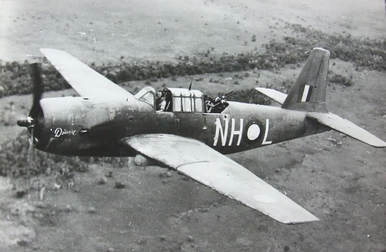
Hoover was posted – to another test unit. He flew anything that came out of a crate. He had to belly land a Douglas A-20 Havoc when the undercarriage refused to extend. When testing a Vultee Vengeance, he lowered the gear and reduced the throttle and flames spewed out. Opening the throttle caused the flames to disappear so he climbed for height in case they had to bail out. When he closed the throttle again there was an explosion which blew off the bomb bay doors.
With flames burning his legs he told the sergeant in the back seat to jump. He was reluctant to go but the flames finally convinced him and he climbed out. His harness snagged the machine gun mounting and he hung there, banging against the side of the fuselage. Hoover rolled the Vengeance inverted, managed to shake off the sergeant and switched off the engine. The flames subsided and he did another dead-stick landing.
With flames burning his legs he told the sergeant in the back seat to jump. He was reluctant to go but the flames finally convinced him and he climbed out. His harness snagged the machine gun mounting and he hung there, banging against the side of the fuselage. Hoover rolled the Vengeance inverted, managed to shake off the sergeant and switched off the engine. The flames subsided and he did another dead-stick landing.
He was testing weapons as well as planes. He became proficient at hitting ground targets accurately and experimented with attacking whilst flying inverted. Then, making sure that his loops were exactly circular (most pilots, he says, fly oval loops) he hit the target from attacks at the bottom of four consecutive loops. No one else was interested in his unusual achievement but he had the satisfaction of polishing his piloting skills.
At last, Hoover was posted to a combat unit, flying Spitfires on boring convoy patrol duties. His previous CO borrowed him for a special job. A B-26 Marauder had force landed on a beach in Sicily. The B-26’s high wing loading had brought it a reputation as a ‘widow-maker’ and this one was in such a cramped area that no pilot willing to fly it out could be found. Hoover was told he could expect a DFC if he did it successfully.
At last, Hoover was posted to a combat unit, flying Spitfires on boring convoy patrol duties. His previous CO borrowed him for a special job. A B-26 Marauder had force landed on a beach in Sicily. The B-26’s high wing loading had brought it a reputation as a ‘widow-maker’ and this one was in such a cramped area that no pilot willing to fly it out could be found. Hoover was told he could expect a DFC if he did it successfully.
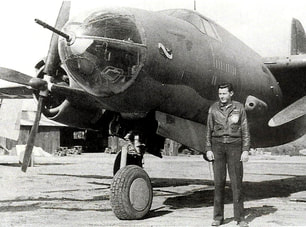
A crew of mechanics stripped the B-26 of as much weight as possible and extended the beach with steel matting and chicken wire. The minimum amount of fuel was loaded.
The first attempt to take off failed when the electric propellers over-speeded. After new batteries were fitted a large crowd of soldiers and pressmen watched the B-26 plough through the sand and lift off in the last few feet of the minimal ‘runway’.
Hoover got his DFC and some publicity in the press ‘back home’.
The first attempt to take off failed when the electric propellers over-speeded. After new batteries were fitted a large crowd of soldiers and pressmen watched the B-26 plough through the sand and lift off in the last few feet of the minimal ‘runway’.
Hoover got his DFC and some publicity in the press ‘back home’.
The squadron moved to Calvi in northern Corsica. It was a confusing time for pilots eager for combat with the enemy. They were scrambled to intercept a large formation of bombers only to be told, at the last minute, that they were surrendering Italians. The real enemy was in southern France and northern Italy. The Spitfires were loaded with bombs and sent on offensive patrols against shipping and trains.
On 9th February 1944, flying a Spitfire Vc, Hoover led a flight of four. Near Nice, they attacked a small convoy and were recovering from their dives when they were set upon by four FW 190s. Hoover tried to jettison his drop tank. The handle broke off. He was distracted by seeing his friend’s Spitfire go down with in flames but was able to hit a 190 which fell away with a smoking engine.
On 9th February 1944, flying a Spitfire Vc, Hoover led a flight of four. Near Nice, they attacked a small convoy and were recovering from their dives when they were set upon by four FW 190s. Hoover tried to jettison his drop tank. The handle broke off. He was distracted by seeing his friend’s Spitfire go down with in flames but was able to hit a 190 which fell away with a smoking engine.
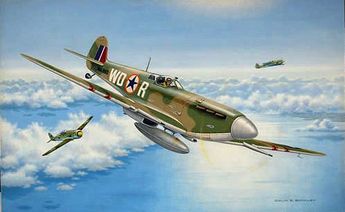
He had successfully fended off the attacks of two 190s when his engine was hit and it burst into flames. He rolled inverted and bailed out. He had been wounded in the legs and his parachute had been damaged in the attack. He struggled to untangle some of the lines before the chute opened properly just a few hundred feet above the sea. The shock of hitting the salt water increased the pain of his wounds and his damaged life raft was useless. He floated in the sea for four hours before rescue came. It was a German corvette.
Life as a POW didn’t start well for Hoover. He tried three times to escape, faced a firing squad during interrogation and was locked in a railway boxcar during a bombing raid on Frankfurt. After a month, he arrived at Stalag Luft 1 at Barth on a peninsula on the shores of the Baltic. Finally, an RAF officer treated his wounds.
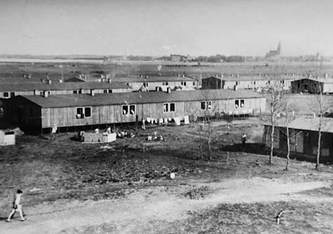
Escape attempts went on. Hoover was lucky to be dug out of a collapsed tunnel and later, almost got away from a coal yard outside the wire where he’d been buried by his friends. It always ended in ‘the cooler’. In April 1945, the Russians were approaching. German guards began deserting and many prisoners were unsure of proper treatment by their allies.
Hoover teamed up with Jerry Ennis, an American who could speak French and a Canadian named George. They had found a long plank under one of the huts. With the guards distracted by a staged fight the three escapees straddled the wire with the plank and successfully got away.
Hoover teamed up with Jerry Ennis, an American who could speak French and a Canadian named George. They had found a long plank under one of the huts. With the guards distracted by a staged fight the three escapees straddled the wire with the plank and successfully got away.
As they headed west they ran into a group of Russian soldiers, mostly drunk. They realised that the main offensive had by-passed the camp. They also met French workers and German civilians, all trying to avoid the Russians. A French women gave them a small pistol.
Then they came across an airfield, abandoned by all but a few Germans, which had been used as a repair base for FW 190s. During his captivity Hoover had had long conversations with a fellow prisoner who had flown a captured 190 so when he found one apparently serviceable and with full tanks he determined to fly it out. Jerry Ennis elected to stay on the ground. With the ‘help’ of a German mechanic at pistol point, they started the engine and Hoover taxied out.
He kept low, following the coastline, careful to avoid Allied fighters. Eventually he reached Holland and rather than land on an airfield whose runway could have been mined by the retreating Germans, he chose a large field. Some Dutch farmers, who thought he might be a deserting German, took him to a nearby, more hospitable, British unit.
The war was over and Hoover’s old squadron commander had moved up the military hierarchy but had not forgotten his exceptional piloting skills and experience. He recommended that, although he lacked the engineering background normally required, Bob should join the USAAC’s unit at Wright Paterson air base in Dayton, Ohio, test flying new and ex-enemy aircraft.
Then they came across an airfield, abandoned by all but a few Germans, which had been used as a repair base for FW 190s. During his captivity Hoover had had long conversations with a fellow prisoner who had flown a captured 190 so when he found one apparently serviceable and with full tanks he determined to fly it out. Jerry Ennis elected to stay on the ground. With the ‘help’ of a German mechanic at pistol point, they started the engine and Hoover taxied out.
He kept low, following the coastline, careful to avoid Allied fighters. Eventually he reached Holland and rather than land on an airfield whose runway could have been mined by the retreating Germans, he chose a large field. Some Dutch farmers, who thought he might be a deserting German, took him to a nearby, more hospitable, British unit.
The war was over and Hoover’s old squadron commander had moved up the military hierarchy but had not forgotten his exceptional piloting skills and experience. He recommended that, although he lacked the engineering background normally required, Bob should join the USAAC’s unit at Wright Paterson air base in Dayton, Ohio, test flying new and ex-enemy aircraft.
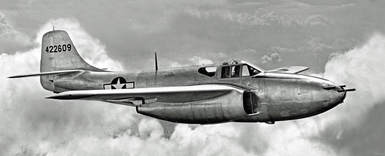
One of his first assignments was compressibility testing the P-47 Thunderbolt. He also had access to all of the other types in service as well as the early jets. It was whilst flying a P-38 Lightning that he met a P-59, a Bell Aerocomet, the first US jet in service. They began a dog-fight, inconclusive but intense. When they landed to compare notes, it was the first meeting of Bob Hoover and Chuck Yeager who were to become life-long friends
Hoover learned to handle jet engines in the P-59, which he enjoyed flying. He later flew the ‘simple’ German Heinkel 162, which frightened everyone and which he found ‘difficult’. Then he met the Lockheed P-80 which had all its early problems sorted out and was a pleasure to fly. Hoover loved showing it off but soon learned that beating up a friend’s house in a noisy jet brought in too many complaints for that practice to continue.
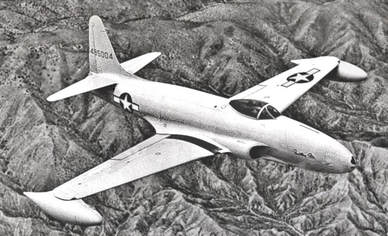
Jets used kerosene and in 1946 this was available at only a few airfields. Supplies of kerosene had to be trucked in if a jet was to operate away from its home. Tests were needed to see if gasoline, with its lower flash point, could be used. An engine was run safely on a test stand. Then it was installed in a P-80 with the aft section of the fuselage left off. The canopy was also removed and Hoover sat in the cockpit, running the engine for an hour at a time with five fire trucks around ready to spray him with water at the slightest trace of a fire. The fifteen hours he spent there were the most boring and the lowest point of his career as a test pilot.
To entertain a visiting general Hoover was asked to perform an aerobatic display in the gas-powered P-80. It was all going well until the gasoline ‘coked up the burner cans’ and the engine flamed out. The only landing spot available was a road with cars parked on both sides. Hoover tried to pump down the wheels but the red lights stayed on. Although he avoided the cars the partly lowered undercarriage collapsed and the rear fuselage broke off. The canopy release mechanism was jammed and Hoover was trapped in the cockpit with a hot engine behind him. He regretted the absence of those fire trucks. Happily, there was no fire and rescuers chopped open the canopy.
The Bell X-1 was being developed to attack the sound barrier. Bell’s test pilot had taken the X-1 to Mach 0.8 and was asking $150,000 for the first flight to exceed Mach 1. Clearly, a military pilot would be cheaper. Hoover and Yeager put themselves on the list.
Hoover had been asked to do a fly-by over Springfield airport and naturally, added a couple of inverted fly-bys. Unfortunately, a Civil Aeronautics Administration official saw the display and filed a ‘safety violation’ report. Hoover was on the carpet and his CO told that, although he’d be on the X-1 project he’d be relegated to back-up pilot.
Bob Hoover and Chuck Yeager moved to Muroc where they did not feel that they were welcomed by the civilian test pilots. They were regarded by some as low-ranking military test pilots – junior and therefore expendable. The outcome, of course, proved otherwise.
The Bell X-1 was being developed to attack the sound barrier. Bell’s test pilot had taken the X-1 to Mach 0.8 and was asking $150,000 for the first flight to exceed Mach 1. Clearly, a military pilot would be cheaper. Hoover and Yeager put themselves on the list.
Hoover had been asked to do a fly-by over Springfield airport and naturally, added a couple of inverted fly-bys. Unfortunately, a Civil Aeronautics Administration official saw the display and filed a ‘safety violation’ report. Hoover was on the carpet and his CO told that, although he’d be on the X-1 project he’d be relegated to back-up pilot.
Bob Hoover and Chuck Yeager moved to Muroc where they did not feel that they were welcomed by the civilian test pilots. They were regarded by some as low-ranking military test pilots – junior and therefore expendable. The outcome, of course, proved otherwise.
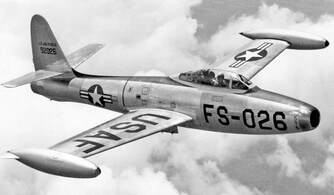
Just a month after the first successful supersonic flight, Hoover had a serious accident. The engine of his F-84 caught fire and burned away the control runs. The Thunderjet went into a steep dive. The ejection seat failed to work. Hoover unfastened his harness, oxygen and leads and jettisoned the canopy. He was sucked out and he slammed into the tail. Despite a blow to the head he was conscious enough to pull the ripcord. He was sure that his legs were broken.
The strong wind and heavy landing added to his pain and the inflated parachute dragged him through the desert brush. Finally, he stopped and lay still in agony.
The strong wind and heavy landing added to his pain and the inflated parachute dragged him through the desert brush. Finally, he stopped and lay still in agony.
He could see planes circling the burning wreck of the F-84 which was 10 or more miles away from where he lay. If the searchers thought he had died in the crash they wouldn’t look for him. The sun went down and Hoover wondered whether he would survive the cold night. Just before dark, a truck came into view. A farm hand had seen the parachute coming down and had taken hours to find it in the desert. It was a painful drive to the Antelope Valley Hospital.
Despite his condition, no-one offered to treat him. They thought that, because he was military, they might not get paid. They did tell Muroc, who sent an old ambulance to collect him for another excruciating trip. Though both legs were equally painful they found that just the left leg was broken and Hoover acquired a cast from ankle to hip. It was some weeks later that new X-rays found that the right knee had also been fractured. By the time his protracted convalescence came to an end his place on the X-1 programme had been filled and he went back to Wright Field.
Despite his condition, no-one offered to treat him. They thought that, because he was military, they might not get paid. They did tell Muroc, who sent an old ambulance to collect him for another excruciating trip. Though both legs were equally painful they found that just the left leg was broken and Hoover acquired a cast from ankle to hip. It was some weeks later that new X-rays found that the right knee had also been fractured. By the time his protracted convalescence came to an end his place on the X-1 programme had been filled and he went back to Wright Field.
At the end of 1948 Bob left military service and briefly became a test pilot for Allison, the engine manufacturers. Then he was contacted by North American with ‘an offer he couldn’t refuse’. His first job was to test the F-86 Sabre fitted with a rocket pod. This contained twenty-four 2.75 in rockets. The rockets had been fired in ones and two and Bob was to make the first firing of all 24.
Luckily, the rockets were not fitted with warheads because the pod failed to extend and the rockets went out through the nose. There was a ball of flame, the engine vibrated violently and stopped. To conserve battery power, Bob switched off everything except the emergency flight controls. He glided down to land on a desert road and decided not to use the battery powered flaps. After a long run, the plane stopped safely and he pressed the button to open the canopy. Nothing happened. There was no battery power left.
Trapped in a greenhouse, he considered jettisoning the canopy but was concerned that the ejection seat might also fire. He went through contortions in the tight cockpit to strip off his flying suit. It was an hour before rescue arrived, by which time Bob was almost naked – and roasted.
North American were developing one of the first ‘fly-by-wire’ control systems for the F-86 and it seemed to be progressing well. Until. . . Bob took off and when he retracted the gear the nose pitched up and the controls locked. The stick was immovable. The climb ended in a hammerhead stall and a spin. Luckily, the rudder was still working so Bob could stop the spin and the Sabre swooped down, missing the roof of a hangar by only twenty feet. The pattern was repeated, each time gaining a little height. He was urged to eject but refused because the Sabre could crash into houses below. Eventually, experiments with power changes, gear and flaps, trim switches and circuit breakers restored some minimal control.
He approached a dry lake bed. The power needed to keep the nose up meant he was flying at 240 knots. At the last second, a little bit of ground effect helped to give him a surprisingly smooth landing. It was the anti-climactic end to what Hoover acknowledged to be the most frightening flight of his long career.
The war in Korea broke out in June 1950 and the F-86 was soon in action against the Mig-15. The USAF asked North American for improved performance and better bombing accuracy. A wing with the leading edge slats locked was tested. Although it did affect take-off performance it gave a much better rate of climb and provided extra space for the storage of fuel in the ‘solid’ leading edge. Hoover dropped dozens of bombs to find the best angle of dive to achieve hits on target. His delight on being asked to go to Korea for the immediate training of the pilots there was tinged by the strict instruction that he was NOT to go into combat.
He was received by the young pilots with some skepticism – ‘an old guy in a business suit and a straw hat’. He proved his credentials by borrowing one of their Sabres – ‘any one that’s serviceable’- and flying one of his spectacular demonstrations. They were impressed and listened as he told them why a loaded Sabre with the solid leading edge would not take off if the nose was raised too soon. He explained his bombing method which they would practise using chinagraph pencil lines marked on the canopies to help to achieve the correct angle of dive.
When the squadron was ready, Hoover was given special permission to fly an attack mission. Sixteen planes took off; Hoover flew as No 2 to the Group Commander. The target was a bridge which was surrounded with the bomb craters from previous attacks but which was still standing. The colonel and Hoover dived down to the bridge, the angle was good and they released their bombs. Two scored direct hits on the bridge and it collapsed. When they rejoined the formation someone noticed that the colonel’s bombs had not released. Hoover had given the most convincing demonstration possible of the effectiveness of his attack technique.
In 1955, North American appointed Gen. Austin Davis to be the new General Manager for the company’s division which produced military aircraft. He asked for Bob Hoover to be appointed as his executive assistant. As part of his duties he flew demonstrations in military aircraft all over the country. As he was a civilian there were concerns about liability and North America looked for a surplus F-86 to buy so that he could continue his popular displays. None was available, so they settled for an F-51, Mustang, quintessentially North American.
Trapped in a greenhouse, he considered jettisoning the canopy but was concerned that the ejection seat might also fire. He went through contortions in the tight cockpit to strip off his flying suit. It was an hour before rescue arrived, by which time Bob was almost naked – and roasted.
North American were developing one of the first ‘fly-by-wire’ control systems for the F-86 and it seemed to be progressing well. Until. . . Bob took off and when he retracted the gear the nose pitched up and the controls locked. The stick was immovable. The climb ended in a hammerhead stall and a spin. Luckily, the rudder was still working so Bob could stop the spin and the Sabre swooped down, missing the roof of a hangar by only twenty feet. The pattern was repeated, each time gaining a little height. He was urged to eject but refused because the Sabre could crash into houses below. Eventually, experiments with power changes, gear and flaps, trim switches and circuit breakers restored some minimal control.
He approached a dry lake bed. The power needed to keep the nose up meant he was flying at 240 knots. At the last second, a little bit of ground effect helped to give him a surprisingly smooth landing. It was the anti-climactic end to what Hoover acknowledged to be the most frightening flight of his long career.
The war in Korea broke out in June 1950 and the F-86 was soon in action against the Mig-15. The USAF asked North American for improved performance and better bombing accuracy. A wing with the leading edge slats locked was tested. Although it did affect take-off performance it gave a much better rate of climb and provided extra space for the storage of fuel in the ‘solid’ leading edge. Hoover dropped dozens of bombs to find the best angle of dive to achieve hits on target. His delight on being asked to go to Korea for the immediate training of the pilots there was tinged by the strict instruction that he was NOT to go into combat.
He was received by the young pilots with some skepticism – ‘an old guy in a business suit and a straw hat’. He proved his credentials by borrowing one of their Sabres – ‘any one that’s serviceable’- and flying one of his spectacular demonstrations. They were impressed and listened as he told them why a loaded Sabre with the solid leading edge would not take off if the nose was raised too soon. He explained his bombing method which they would practise using chinagraph pencil lines marked on the canopies to help to achieve the correct angle of dive.
When the squadron was ready, Hoover was given special permission to fly an attack mission. Sixteen planes took off; Hoover flew as No 2 to the Group Commander. The target was a bridge which was surrounded with the bomb craters from previous attacks but which was still standing. The colonel and Hoover dived down to the bridge, the angle was good and they released their bombs. Two scored direct hits on the bridge and it collapsed. When they rejoined the formation someone noticed that the colonel’s bombs had not released. Hoover had given the most convincing demonstration possible of the effectiveness of his attack technique.
In 1955, North American appointed Gen. Austin Davis to be the new General Manager for the company’s division which produced military aircraft. He asked for Bob Hoover to be appointed as his executive assistant. As part of his duties he flew demonstrations in military aircraft all over the country. As he was a civilian there were concerns about liability and North America looked for a surplus F-86 to buy so that he could continue his popular displays. None was available, so they settled for an F-51, Mustang, quintessentially North American.
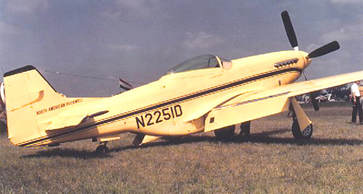
He displayed the Mustang all over North America, in South America and the Far East, always wearing a business suit and tie, sporting a straw hat when he wasn’t in the cockpit. When the Reno Air Races were inaugurated in 1964, Hoover’s Mustang was the official starter and safety plane. The following year, his display had become such an essential part of the public face of North American that he went with the team to the Paris Air Show.
(His Mustang stayed at home and he borrowed one from Belgium).
(His Mustang stayed at home and he borrowed one from Belgium).
Another individual ‘star’ at the show was with the Russian delegation. It was Yuri Gagarin and the press were eager to arrange a ‘Bob and Yuri’ photoshoot. It’s hard to understand why they were taken water-skiing together but the meeting would turn out to have an unusual benefit.
In 1966, the International Aerobatic Competition was being held in Moscow. Although Bob didn’t fly competition aerobatics he was urged to go as non-flying Team Captain. The CIA hoped that he could use his contact with the Russians to glean some intelligence about their latest military aircraft - even manage to get a flight in one. The nearest he got was an offer to fly one of the aerobatic Yak-18s which had trounced the opposition.
In 1966, the International Aerobatic Competition was being held in Moscow. Although Bob didn’t fly competition aerobatics he was urged to go as non-flying Team Captain. The CIA hoped that he could use his contact with the Russians to glean some intelligence about their latest military aircraft - even manage to get a flight in one. The nearest he got was an offer to fly one of the aerobatic Yak-18s which had trounced the opposition.
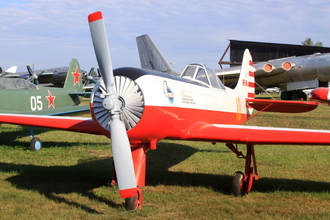
He was delighted with the power and controllability of the Yak, did a half-roll after take-off and disappeared, upside down, over the dyke which surrounded the airfield. He kept out of sight as he flew down the river and re-appeared in a zoom to carry out his display of loops and multi-point rolls, much of it far lower than the 100 metre minimum height imposed on the Soviet pilots and ending with his usual one wheel after the other landing.
His interpreter pushed through the cheering crowd to tell him he was under arrest. Then, a particular Russian contact came to his aid. Yuri Gargarin sought him out, prised him from the guards with a bear hug and he left for home without ‘intelligence’ and without punishment.
His interpreter pushed through the cheering crowd to tell him he was under arrest. Then, a particular Russian contact came to his aid. Yuri Gargarin sought him out, prised him from the guards with a bear hug and he left for home without ‘intelligence’ and without punishment.
North American had become Rockwell International and Bob got involved in some record-breaking. Rockwell took their Aero-Commander 690 Turbo to the1978 Hanover Airshow. They planned to do time to height records to 10,000, 20,000 and 30,000 feet. The plane was stripped of all unnecessary weight, including cabin furnishings and heaters. Bob climbed into an already cold aeroplane for an early morning take off. He was climbing in cloud when, at 13,000 ft, all instruments, radios and navigation equipment failed. Bob continued climbing on basic instruments, navigating by guesswork.
In the control room, the only contact with the plane was the radar trace and it wandered into East German airspace. There was a the real possibility he could be shot down. Bob continued to 32,000 ft, confident that he’d broken the records. He saw three contrails and realised that they must be Russian Migs so he dived for west and home. Sadly, the recorders had failed so there was no record. Bob wanted a day or two to thaw out but that wasn’t possible. Cold as he was, he took off again. It was almost a repeat performance. Instruments and radio failure at 13,000 ft and again he failed to keep out of the forbidden airspace. The patrolling Migs were even closer but he dived at red-line speed into the overcast and escaped. This time, the recorders worked and the records were in the bag.
In the control room, the only contact with the plane was the radar trace and it wandered into East German airspace. There was a the real possibility he could be shot down. Bob continued to 32,000 ft, confident that he’d broken the records. He saw three contrails and realised that they must be Russian Migs so he dived for west and home. Sadly, the recorders had failed so there was no record. Bob wanted a day or two to thaw out but that wasn’t possible. Cold as he was, he took off again. It was almost a repeat performance. Instruments and radio failure at 13,000 ft and again he failed to keep out of the forbidden airspace. The patrolling Migs were even closer but he dived at red-line speed into the overcast and escaped. This time, the recorders worked and the records were in the bag.
Bob’s other records include several point-to-point records in the Sabreliner and, set when he was aged 63, a coast-to-coast flight in his Mustang from Los Angeles to Florida at 409.83 mph. After he retired from Rockwell he continued his displays and race starting duties at Reno in ‘Ole Yeller’.
When he was 70, one of his airshows was witnessed by two FAA inspectors who claimed that he had performed poorly. He did another 33 displays before the FAA decided to withdraw his licence ‘on medical grounds’. A series of medical tests followed, at Bob’s expense, including one by an FAA appointed doctor who found nothing wrong. The licence wasn’t restored.
Bob appointed a lawyer to fight his case. He suggested a videotape of Bob’s display would help so they hired a T-28 Trainer and Bob took a licensed safety pilot, with a camera, in the back seat. The display was almost finished when a warning light came on indicating the detection of metal in the oil system. Immediately, the propeller governor failed and the engine over-speeded. It needed constant manipulation of the throttle, mixture and prop controls to keep the engine running through occasional backfiring. They made it back to the runway and at touchdown, the vibrating engine seized, the attachment points broke and the engine was twisted on its mounting.
When he was 70, one of his airshows was witnessed by two FAA inspectors who claimed that he had performed poorly. He did another 33 displays before the FAA decided to withdraw his licence ‘on medical grounds’. A series of medical tests followed, at Bob’s expense, including one by an FAA appointed doctor who found nothing wrong. The licence wasn’t restored.
Bob appointed a lawyer to fight his case. He suggested a videotape of Bob’s display would help so they hired a T-28 Trainer and Bob took a licensed safety pilot, with a camera, in the back seat. The display was almost finished when a warning light came on indicating the detection of metal in the oil system. Immediately, the propeller governor failed and the engine over-speeded. It needed constant manipulation of the throttle, mixture and prop controls to keep the engine running through occasional backfiring. They made it back to the runway and at touchdown, the vibrating engine seized, the attachment points broke and the engine was twisted on its mounting.
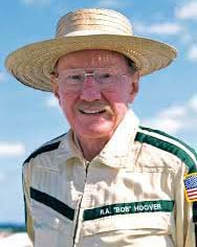
Even that evidence of capable airmanship failed to move the FAA. Bob went to Australia. He carried out all the flight and medical tests, passed the exams and was awarded an Australian commercial licence. He could fly anywhere in the world – except in the USA. Bob’s friends rallied round and a strong ‘Let Bob fly’ protest movement developed. The case even went as far as the Supreme Court until at last, after eighteen nightmare months and with no explanation or apology, the licence was restored.
Bob began flying again in December 1995. He retired himself from airshows in 1999 and his farewell flight in the Shrike Commander was in 2003 (aged 82).
Bob Hoover has been honoured by every American and many foreign aviation organizations and has been showered with awards. He stands tall in the ranks of America’s aviation heroes.
Bob began flying again in December 1995. He retired himself from airshows in 1999 and his farewell flight in the Shrike Commander was in 2003 (aged 82).
Bob Hoover has been honoured by every American and many foreign aviation organizations and has been showered with awards. He stands tall in the ranks of America’s aviation heroes.
